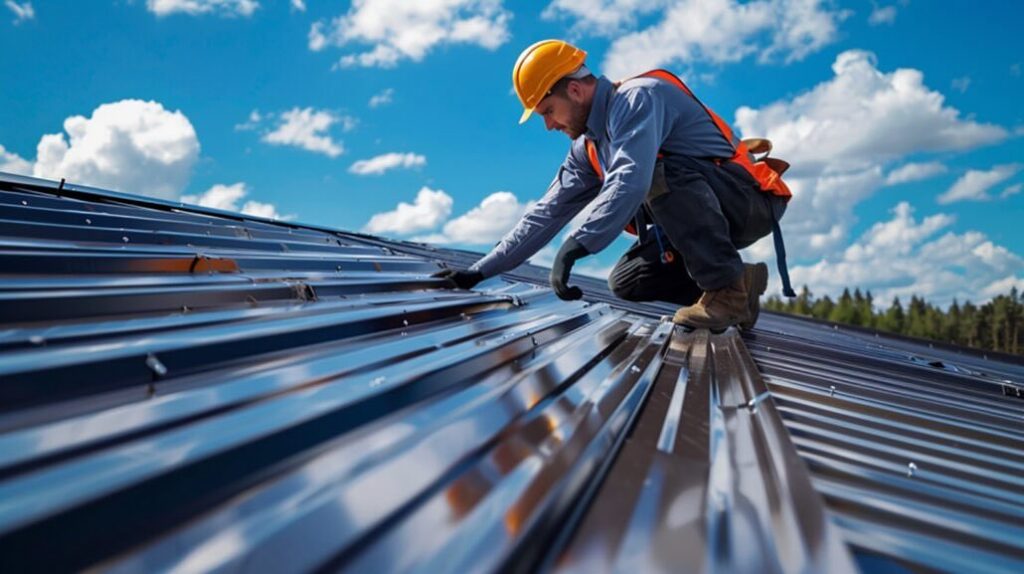Warehouses and factories are vital in keeping the supply chain and manufacturing industries running. They store expensive equipment, raw materials, and finished products. That’s why having a good roof over them is crucial. A well-planned roofing system protects everything inside and helps operations run smoothly.
Choosing the right roofing solution means balancing durability, cost, and practicality. When it comes to commercial roofing, you need a professional team that understands the unique demands of commercial structures.
Here, we’ll cover the best roofing options and their benefits.
Importance of a Suitable Roofing System
The right roof plays a critical role in safeguarding warehouses and factories. These large structures are particularly vulnerable to damage from weather and other external factors.
A high-quality roofing system protects your inventory and equipment from water damage, which could otherwise lead to costly repairs or losses. Additionally, it helps in controlling indoor temperatures, leading to better energy efficiency and reduced utility bills.
A good roof also minimizes maintenance costs and increases the building’s lifespan. This ensures smooth and safe operations for workers and processes.
Key Considerations When Choosing a Commerical Roof
Selecting a roofing system for your warehouse or factory requires careful thought. Durability is a top priority, as the roof must withstand harsh weather and wear over time to safeguard your investment.
Energy efficiency is another key factor, as it can significantly reduce heating and cooling expenses. The ease of maintenance is equally important, ensuring that the roof remains functional with minimal upkeep.
Work with an experienced roofing company to help you navigate local climate challenges, ensuring your roof is built to last. Choose the best roofing contractors in Idaho or your area offering free estimates, discounts, and a detailed project plan and honoring manufacturer warranties for quality work and peace of mind.
Cost is always a consideration, both in terms of initial investment and long-term expenses. Finally, adaptability matters if you plan to incorporate features like solar panels or skylights in the future.
Top Roofing Solutions for Warehouses and Factories
1. Metal Roofing
Metal roofs are a popular choice due to their exceptional durability and low maintenance requirements. They are typically made from materials like steel or aluminum, offering a lifespan of 40 to 70 years.
Advantages:
- Can handle extreme weather like wind, hail, and snow.
- Strong but lightweight, so they don’t strain the structure.
- Eco-friendly because they’re recyclable.
- Energy-efficient coatings are available.
2. TPO (Thermoplastic Olefin) Roofing
TPO roofing is a single-ply membrane that works well for flat or low-sloped roofs. It is known for its energy efficiency and cost-effectiveness.
Advantages:
- Blocks UV rays and heat, which lowers cooling costs.
- Resists tears and punctures.
- Budget-friendly and simple to install.
3. EPDM (Ethylene Propylene Diene Monomer) Roofing
EPDM, often called rubber roofing, is a durable and affordable option that has been widely used for commercial buildings.
Advantages:
- Great at resisting UV rays and ozone.
- Can last up to 30 years with little maintenance.
- Affordable for covering large spaces.
4. PVC (Polyvinyl Chloride) Roofing
PVC roofing is both tough and flexible, making it ideal for factories or warehouses that deal with chemicals or other challenging environments.
Advantages:
- Resistant to chemicals, grease, and fire.
- Reflects heat, improving energy efficiency.
- Seamless design prevents leaks.
5. Built-Up Roofing (BUR)
BUR systems are constructed from layers of bitumen and reinforcing fabric. This traditional roofing solution is commonly used for flat roofs.
Advantages:
- Excellent waterproofing and durability.
- Multiple layers mean fewer leaks.
- Cost-effective for larger buildings.
6. Modified Bitumen Roofing
Modified bitumen is an enhanced version of BUR that offers added flexibility and strength.
Advantages:
- Performs well in extreme weather, whether hot or cold.
- Easy to fix and maintain.
- Reflective coatings improve energy efficiency.
7. Green Roofing
Green roofs consist of vegetation grown on a waterproof membrane, providing both environmental and aesthetic benefits.
Advantages:
- Insulates well, cutting down energy costs.
- Reduces rainwater runoff and drainage problems.
- Adds to the building’s visual appeal while helping the environment.
Maintenance Tips for Commercial Roofs
Proper maintenance ensures that your roofing system remains effective for years to come. Regular inspections are essential to catch issues early before they become major problems.
Cleaning gutters and drains prevents water buildup, which can lead to leaks or structural damage. Addressing small damages like cracks immediately can save money in the long run.
Additionally, applying protective coatings can enhance durability and energy efficiency, prolonging the roof’s lifespan.
Conclusion
Choosing the right roof for your warehouse or factory is a decision that depends on your specific needs and budget. Options like metal, TPO, EPDM, and PVC roofs are durable and efficient, while green roofs cater to businesses focused on sustainability.
Regular maintenance is key to maximizing the benefits of your roofing solution, protecting your investments, and ensuring seamless operations.
Ultimately, the right roof does more than just shield your building from the elements; it improves energy efficiency, reduces maintenance costs, and enhances the overall functionality of your space. Whatever your priorities may be, there is a roofing solution to meet your requirements.

